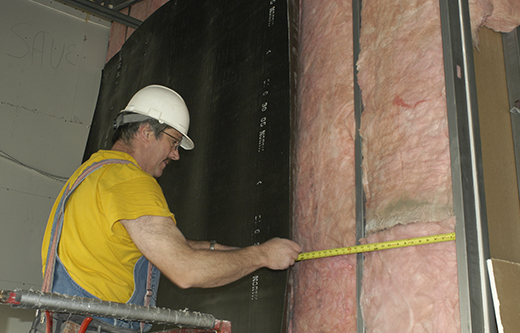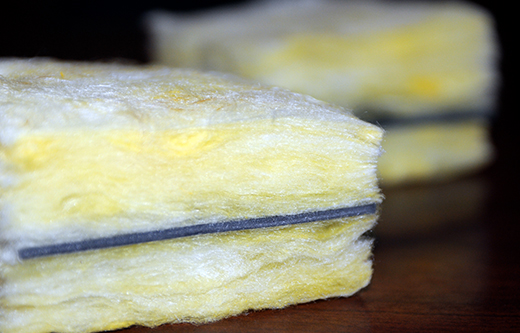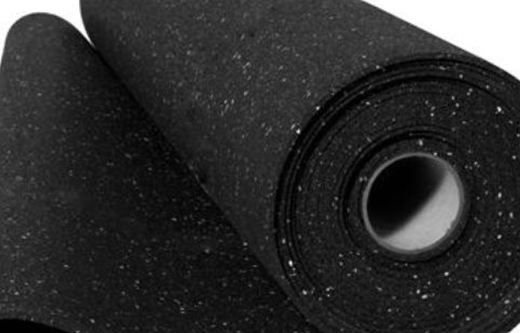Soundproofing Insulation Products
The noise reduction products featured here are designed to block noise. From soundproofing common walls, to isolating common floor/ceiling assembly’s, to lining machine enclosures, wrapping drainpipes or serving as room dividers. These soundproofing products will help lower noise level exposures and make your space more user friendly and functional.
What Products Can Block Sound?
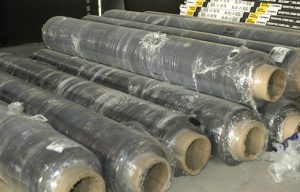
Soundproofing products that deaden sound bleed are typically dense, weighted membranes that wrap or layer around a surface to help combat the transmission of noise through a common surface. These noise reduction products can layer between common walls, ceilings, floors, around drain pipes, inside machine enclosures and above ceiling tile systems. The goal with these sound barrier products is to isolate noise, contain it to one side of the treatment, and not let the energy pass through. These soundproofing products can reduce up to 80% of the exposure to noise if layered in properly.
Does insulation block noise bleed?
Batting insulation separates kinetic energy (thermal) but does little to combat sound wave energy. Sound waves bleed straight through the batting insulation. To properly deaden sound bleed, density is required to force the collapse of the transmitting sound wave. The soundproofing products featured on this page are all dense and weighted for this reason. This is important to note when attempting to soundproof a wall, ceiling or flooring assembly. It matters less what you fill the cavity space with between your studs. It matters more that you layer density into the assembly, across the face of the entire framing system, and then force disconnection. Disconnection will collapse structure born vibrations from passing the sound wave through. If your goal is to isolate one room’s noise from the next, do not rely on batting insulation. Instead, focus on a dense membrane called mass loaded vinyl. See dB-Bloc here on our website.
Questions? Call 1-800-638-9355
How to Block Sound Between Two Rooms
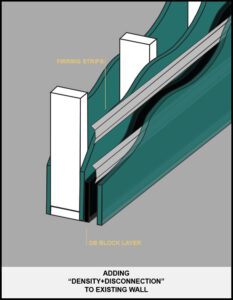 Whether the common wall is existing finished, or new build, the goal is twofold. First, layer density into the assembly by tacking dB-Bloc to the common surface. Either straight to the existing drywall, or to the exposed frame. And second, disconnect the rooms by following simple framing techniques. If your wall is finished, add a set of resilient channels or hat channels to the wall, and attach new drywall to the face of the channels. By forcing separation, you give the transmitting sound wave a chance to collapse within your common wall assembly, rather than letting the sound wave pass through by vibration. See dB-Bloc for the barrier portion for your wall soundproofing. Call our help desk for more questions. 1-800-638-9355.
Whether the common wall is existing finished, or new build, the goal is twofold. First, layer density into the assembly by tacking dB-Bloc to the common surface. Either straight to the existing drywall, or to the exposed frame. And second, disconnect the rooms by following simple framing techniques. If your wall is finished, add a set of resilient channels or hat channels to the wall, and attach new drywall to the face of the channels. By forcing separation, you give the transmitting sound wave a chance to collapse within your common wall assembly, rather than letting the sound wave pass through by vibration. See dB-Bloc for the barrier portion for your wall soundproofing. Call our help desk for more questions. 1-800-638-9355.
Noise Reduction through Common Walls
Two rooms that share a common wall are connected together by the frame inside the wall. That frame serves the same as a string pulled tight between two cans. The goal is to cut the string and force a collapse in the vibration pulling the energy back and forth. Soundproofing a wall is all about breaking the contact point, and lining the assembly with additional weight to reduce noise between two spaces. Sound isolation clips are an ideal way to force disconnection between two rooms. See the RSIC Clips to discover how to help block sound bleed through common surfaces.
Soundproof Room Dividers
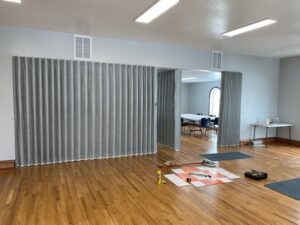 For sound isolation within the same room, dividing one side of the room from the opposite side, sound barrier room dividers are available that can serve to split the room into two user-friendly spaces. Ceiling mounted room dividers, called Curtitions, can be retrofit into the room to glide open and shut for soundproofing a room. These are accordion style sound barrier curtain systems that can help generate a more user friendly and functional space. See Curtitions.
For sound isolation within the same room, dividing one side of the room from the opposite side, sound barrier room dividers are available that can serve to split the room into two user-friendly spaces. Ceiling mounted room dividers, called Curtitions, can be retrofit into the room to glide open and shut for soundproofing a room. These are accordion style sound barrier curtain systems that can help generate a more user friendly and functional space. See Curtitions.
Questions? Call 1-800-638-9355
Sound Barrier for Ceilings
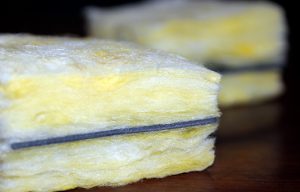 Ceiling tiles do not block noise bleeding into and out of a room through the plenum space. For soundproofing a ceiling tile system, the goal is to add density to the top side of the ceiling tile with a set of Ceiling Caps. These are sound isolation pads that help put a cap over the top of the room to prevent noise bleeding out through the ceiling. If your ceiling is a finished drywall ceiling, layer the same dB-Bloc approach to your ceiling as you do to your wall surfaces. Tack the sound barrier membrane to the ceiling, run a set of furring strips across the ceiling and layer a new sheet of drywall.
Ceiling tiles do not block noise bleeding into and out of a room through the plenum space. For soundproofing a ceiling tile system, the goal is to add density to the top side of the ceiling tile with a set of Ceiling Caps. These are sound isolation pads that help put a cap over the top of the room to prevent noise bleeding out through the ceiling. If your ceiling is a finished drywall ceiling, layer the same dB-Bloc approach to your ceiling as you do to your wall surfaces. Tack the sound barrier membrane to the ceiling, run a set of furring strips across the ceiling and layer a new sheet of drywall.
Noise reduction between floors
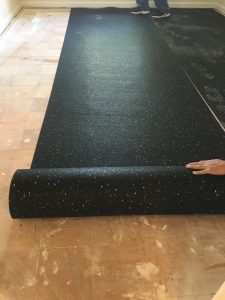 To combat foot noise from bleeding downstairs from upstairs, the goal would be to isolate the floor up above by placing a floor underlayment called FloorFighter down under your finished flooring surface. Many times this is not possible, so you will be left with target the ceiling treatment down below. But for new build or remodel efforts, placing this floor soundproofing membrane below your finished floor upstairs can help deaden noise bleeding down through to the downstairs.
To combat foot noise from bleeding downstairs from upstairs, the goal would be to isolate the floor up above by placing a floor underlayment called FloorFighter down under your finished flooring surface. Many times this is not possible, so you will be left with target the ceiling treatment down below. But for new build or remodel efforts, placing this floor soundproofing membrane below your finished floor upstairs can help deaden noise bleeding down through to the downstairs.
What is Soundproof Insulation?
A common term such as soundproof insulation can have different meanings. Insulation, as in batting insulation, or fiberglass, is not a soundproofing material. Batting insulation does not combat sound waves effectively. Batting insulation is great for thermal protection, but not sound protection. Any product that insulates against sound bleed is heavy, not light, and combats vibrations of sound with mass. See dB-Bloc for properly soundproofing common walls or common ceiling/floor assemblies.
What is a Sound Barrier Membrane
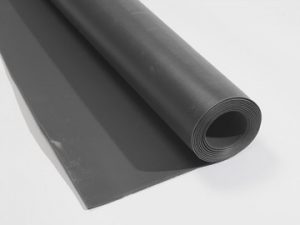 Thin dense mass loaded vinyl is shipped in 54” x 30’ rolls to project sites across America. This dense weighted membrane deadens a wall, ceiling or flooring surface’s ability to accept resonance. If a product can’t vibrate, it can’t conduct or pass long sound wave energy. Placing sound barrier membranes against a common surface is an ideal way to deaden noise bleed. dB-Bloc is shipped in 54″ x 30′ rolls to your job site. Easy to install. Excellent for sound insulating one room’s noise from the next.
Thin dense mass loaded vinyl is shipped in 54” x 30’ rolls to project sites across America. This dense weighted membrane deadens a wall, ceiling or flooring surface’s ability to accept resonance. If a product can’t vibrate, it can’t conduct or pass long sound wave energy. Placing sound barrier membranes against a common surface is an ideal way to deaden noise bleed. dB-Bloc is shipped in 54″ x 30′ rolls to your job site. Easy to install. Excellent for sound insulating one room’s noise from the next.
Questions? Call 1-800-638-9355
How to Soundproof Noisy Drain Pipes
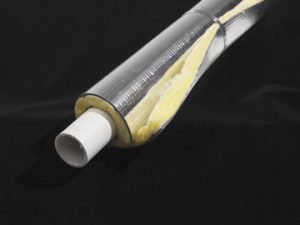 Drain pipes carry liquid flow through them and are often times guilty of letting noise bleed through the walls of the pipe. To combat this, and soundproof the drain pipes, simply wrap the drain pipes with sound barrier lagging material called NetLag. This then sound barrier membrane will serve as a soundproofing jacket that will hold the noise to within the drain pipe.
Drain pipes carry liquid flow through them and are often times guilty of letting noise bleed through the walls of the pipe. To combat this, and soundproof the drain pipes, simply wrap the drain pipes with sound barrier lagging material called NetLag. This then sound barrier membrane will serve as a soundproofing jacket that will hold the noise to within the drain pipe.
Soundproof Ceiling Tiles
Ceiling tiles by themselves are not soundproof. They do not block noise from bleeding into or out of a room through a common plenum space. There are upgrades to a ceiling tile system that can indeed generate the protection against sound transmission through the ceiling. Sound isolation ceiling pads called Ceiling Caps can rest atop the ceiling tiles to help deaden the bleed of noise into or out of the room through the ceiling. Also, there are upgrades to existing ceiling tiles, which are lined with a dense membrane that will give the new finished ceiling tile more density. See Granite Tiles. These finished ceiling tiles are heavy, and will serve to help block noise bleeding through the ceiling. For a soundproofing ceiling tile system.
Do sound panels block noise bleed?
No. Sound panels, wall or ceiling mounted in a room, are there to absorb echoes and deliver back premium sound quality within the room. But sound panels per se do not combine to block noise from bleeding out of the room. For wall soundproofing, or for floor/ceiling noise reduction, the goal is to line the common surface with density, and disconnect the assembly. See Common Wall Soundproofing here on the website. There is also a hybrid product called FabricBloc that will combine to both block the noise bleed out of the space, and absorb the echoes back inside the room. This is an upgrade to a standard sound panel, but no, acoustic panels by themselves will not deaden sound bleeding form one room to the next.
How to I soundproof my room?
To isolate one room’s noise from the next, call our help desk at 1-800-638-9355 and we can guide you through the layering techniques you will need to properly insulate one room’s noise from the next. Soundproofing a common wall, or soundproofing a floor or a ceiling, relies on simple layering techniques that can be added to most any existing or new build common surface. Before you start, call for help to avoid early missteps that can reduce your overall impact, or cost you more than you need to spend.
dB-Bloc
With more than one million square feet of dB-Bloc shipped to project sights throughout America, this sound barrier membrane is our #1 selling product. Clients near and far work to embed this membrane into their perimeter wall or ceiling assemblies to deaden sound bleed.
Ceiling Caps
For clients with noise bleeding through existing drop grid ceiling tile systems, these Ceiling Caps are the perfect sound barrier treatment. Simply rest these Caps above your ceiling tiles to place an acoustic “lid” over your room to prevent the noise bleed.
FloorFighter
For common floor/ceiling assembly systems with clients who have access to their subfloor (remodel/new build), the FloorFighter membrane is the ideal choice for combating common floor/ceiling assembly noise. FloorFighter sound barriers freely float beneath your flooring and help deaden foot noise and other sources of noise. Simply roll the material out and place your flooring surface over it.
